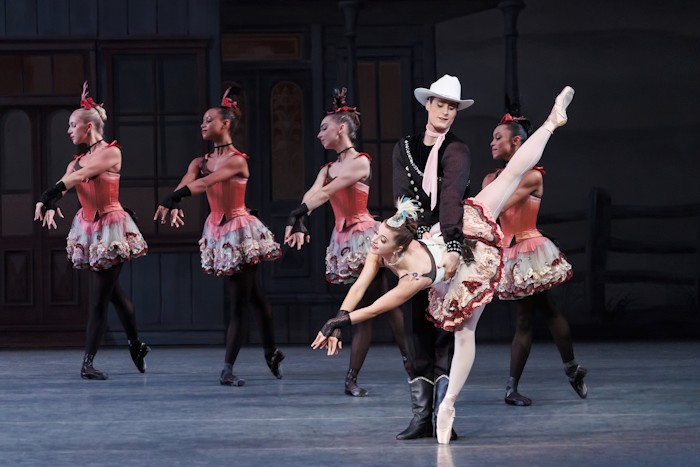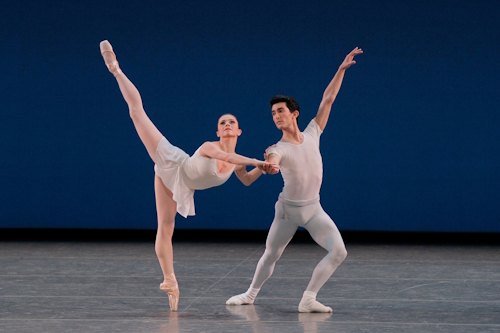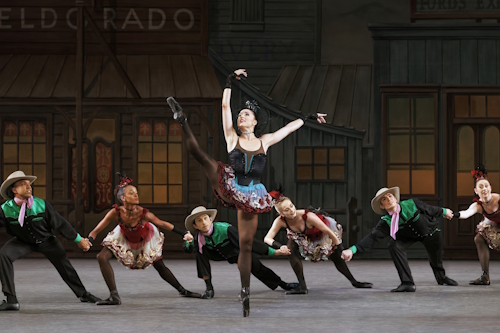David H. Koch Theater, New York City
September 17, 2025
The second of New York City Ballet’s fall season all-Balanchine programmes opened with a lovely account of the bright and light Square Dance, an enjoyable coming together of the spirit of traditional American country dancing, classic ballet, and the Baroque music of Vivaldi and Corelli.
Premiered in 1957, the ballet has always only referenced the patterns and movements of folk dance, although it did originally have the dancers in hoedown costume and come with a caller. Both disappeared in 1976 when Balanchine pared the ballet down significantly, dressing the dancers instead in white and grey. What has not been lost, even another fifty years on, is its sense of joy and playfulness. A showcase of classicism, here led by Megan Fairchild and Anthony Huxley, it still feels wonderfully fresh.
Fairchild was beautifully bright and full of energy, totally at one with the music and sparkling throughout. One long sequence of fast, fluttering, right on the button petit allegro, with echappés galore, will long live in the memory. Huxley certainly matched her for elegance, and was impressive in his more contemplative solo.
They were supported superbly by the zestful ensemble of six couples, who all seemed to be enjoying themselves hugely. And why not? Mia Williams stood out in particular for both her dancing and the way she fully embraced the pleasure of the ballet.
Made in 1959, Episodes is another ballet that has been cut back over the years. Originally a collaboration between New York City Ballet and the Martha Graham Company, it has lost Graham’s section, a meditation on the life of Mary, Queen of Scots, and a solo created by Balanchine on Paul Taylor, then a member of the Graham company. What remains are the four sections Balanchine choreographed for his own dancers.
Episodes is about as far from Square Dance as you can get. With the dancers in black and white, and its spare choreography full of near-mechanical movement, the ballet is often regarded as Balanchine at his most abstract. But while the clean, geometric dance with its many straight lines is largely emotionally detached, it is very much a visualisation of Anton von Webern’s atonal music and its architecture. That music is hard work, but when set with Balanchine’s dance, the two create fascinating pictures. It’s as if a series of modernist paintings have come to life.
In the opening section, to the composer’s Symphony, Op.21, Isabella LaFreniere was supported by Chun Wai Chan and a backing ensemble of three couples. ‘Supported’ is very much the operative word as LaFreniere is held in attitude on a bent leg and even in an upside-down lift in which she crosses her feet in the air.
While three of the sections are brightly lit, the second, to von Webern’s Five Pieces, is a duet danced in the dark, with Ashley Hod and Alec Knight lit only by two spotlights. The lighting focuses the attention beautifully on the bodies and movement. As the couple edge around and run past each other, it feels like they a trapped in some sort of strange dream. With him often following her, as if chasing some ghostly apparition, there’s a clear sense of drama, but it feels like we only see abstracted parts of the story. Utterly intriguing.
Alexa Maxwell and Taylor Stanley led the third section, to Concerto, notable for one section where he manipulates here like a wooden puppet. Think an unusual Coppélia. While retaining its modernist air, the final section to Ricercata in six voices from Bach’s “Musical Offering,” is unexpectedly courtly. Led by Mira Nadon and Adrian Danchig-Waring, and with an ensemble of 14 women, it’s full of architectural patterns.
And to so some fun, and Western Symphony. It may be a little kitschy for some, but with its score by Hershey Kay assembled from classic songs from the American West (I guarantee you’ll be humming tunes all the way home); bright choreography that actually has more overt folk dance references than Square Dance; and humour, it’s a blast.
In the opening Allegro, Ashley Laracey and Jules Mabie were nicely sassy, Laracey showing great buoyancy in her jumps. In the following humorous Adagio, that parodies several classics, Indiana Jones and Aarón Sanz (her dreamy Rhinestone Cowboy) were delightful. Best came in the closing Rondo, however, where the tall Emily Kitka and the rather shorter Roman Mejia had bags of fun. While impressed with her high kicks and fouettés, it was Mejia who brought the house down with his energy, fast footwork, spinning pirouettes and soaring leaps.
Western Symphony is guaranteed to bring a smile to the face. But how even more fabulous it would be if it were returned to its originally intended form, and the with speedy Scherzo put back between the Adagio and Rondo.




